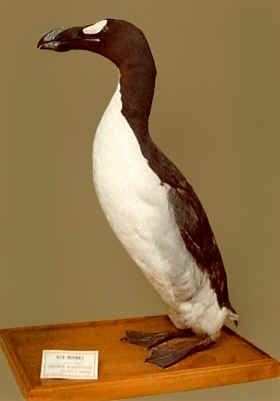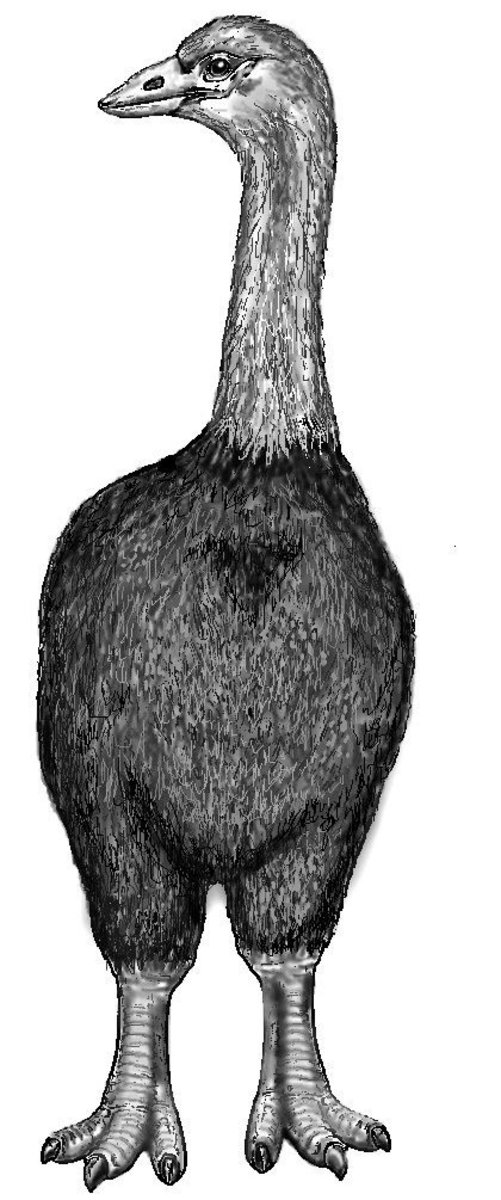The Great Auk

The great auk was a large flightless bird that lived in the north Atlantic. It was nearly three feet tall and weighed about ten pounds. Although It looked very much like a penguin, the two species are unrelated. They both evolved to a similar form, to live in similar environments. While penguins eat fish in the cold waters of the southern hemisphere, the great auk fed on fish in the cold waters of the North Atlantic. Both species became flightless and excellent swimmers. Like penguins, great auks also bred in large, dense colonies.
DNA analysis has shown that the great auk's closest living relative is the razorbill. It is also closely related to the little auk or dovekie. Although related, the little auk is far smaller than the great auk, only about eight inches long.
Human Predation of the Great Auk
It appears that great auks were a human food source for at least 100,000 years. Great auk bones have been found at Neanderthal campsites. Modern humans on both sides of the Atlantic also hunted the great auk.
The great auk spent most of its time at sea, but it had to come ashore to breed. Because of its limited mobility on land, it became susceptible to predators. Suitable breeding sites for the great auk had to be:
- Free from predators
- Have a sloping approach from the sea so they could get out of the water
- Be close to a plentiful supply of food (Typically small fish like capelin and crustaceans)
Therefore great auk breeding sites were typically remote islands with sloping approaches to the ocean. Although the great auk population was once in the millions, it is believed that only about 20 breeding colonies existed.
Humans ate the birds and their eggs for many years, but great auk numbers started to seriously decline when Europeans began to kill them for their feathers. By the 1500s most of the breeding colonies on the European side of the Atlantic had been wiped out. When the New World was colonized, eider ducks became the preferred source of down feathers. By the 1770s eider ducks were nearly extinct, so the feather industry went after the great auks. Funk Island off Newfoundland was once home to the largest breeding colony of great auks. By 1800 they were gone from Funk Island.
The Last Refuge of the Great Auk
By 1820 there was only one breeding colony left in the world - The island of Geirfuglasker off the coast of Iceland. It seemed like the great auk might be able to avoid extinction here. This volcanic rock had two small landing areas where the birds could come ashore. Due to the rough surf around the island, it was difficult and dangerous for humans to approach.
Disaster struck in 1830 when an undersea volcanic eruption caused the island to collapse into the ocean. In 1835 a small great auk colony of about fifty birds was discovered on the nearby Eldey Island. When word of this discovery spread, no attempt was made to save the species from extinction. Instead, museums sent collectors to get specimens before they were gone. The last breeding pair was killed on July 3, 1844 and its egg was smashed.
The last reliable sighting of a great auk occurred in 1852 off Newfoundland's Grand Banks. Return visits were made to Eldey Island in 1846 and 1860, but no great auks were sighted. Many people believed there were undiscovered great auk colonies farther north, but none were ever found.






![Which Big Cats Eat Humans, Lethal Big Cats [Videos] Which Big Cats Eat Humans, Lethal Big Cats [Videos]](https://images.saymedia-content.com/.image/t_share/MTc2Mzc2OTY2MTg0NzcyNzgx/zoos-which-big-cats-eat-humans-lethal-big-cats.jpg)



